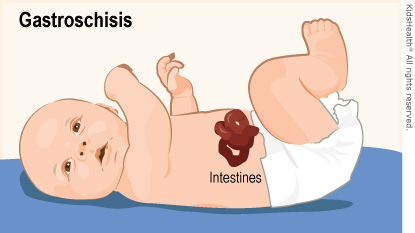Gastroschisis
Article Translations: (Spanish)
What Is Gastroschisis?
Gastroschisis is when a baby is born with the intestines sticking out through a hole in the belly wall near the umbilical cord. Sometimes other organs also stick out. Gastroschisis (gast-roh-SKEE-sis) is a life-threatening condition that needs treatment right away.
What Happens With Gastroschisis?
In normal prenatal development:
- As the organs inside an unborn baby's belly form, the intestines push out through a hole in the belly wall.
- Later, they twist and move back inside the belly, and the hole closes.
When a baby has gastroschisis:
- The intestines stay outside of the belly, keeping the hole in the belly wall from closing.
- When the baby is born, the intestines are visible. Often, they're damaged from weeks of soaking in the amniotic fluid in the womb (uterus). The baby needs treatment right away.

What Are the Signs & Symptoms of Gastroschisis?
A baby born with gastroschisis will lose heat and water very quickly from the intestines, causing:
- too much water loss (dehydration)
- a body temperature that gets too low (hypothermia)
Other organs may stick out along with the intestines, including the baby's:
What Causes Gastroschisis?
Doctors don't know why gastroschisis happens. It is probably due to a combination of genetic and environmental factors. During pregnancy, the intestines grow correctly at first, but then do not go back inside the belly as they usually do.
Gastroschisis is more likely when the mother:
- is under age 20
- smokes during her pregnancy
- drinks alcohol
Gastroschisis is more common now than it has been in previous decades, but doctors don't know why.
How Is Gastroschisis Diagnosed?
A pregnant woman doesn't have any symptoms during pregnancy when her baby has gastroschisis. But doctors might find gastroschisis before the baby is born when the mother has a:
- routine screening ultrasound scan (prenatal ultrasound)
- blood test for a protein called alpha-fetoprotein, which usually runs at a higher level than normal when a fetus has gastroschisis
If the mother did not have prenatal tests, the doctor will diagnose gastroschisis at birth because part of the intestine is outside the baby's body.
How Is Gastroschisis Treated?
In most cases of gastroschisis, the care team includes:
- a high-risk pregnancy specialist (called a maternal-fetal medicine specialist or perinatologist)
- a neonatologist (a pediatrician specializing in complex newborn care)
- a pediatric surgeon
- delivery and neonatal intensive care unit (NICU) critical care nurses
When a baby is diagnosed with gastroschisis, the parents and care team make a plan with several steps:
- They choose a location for the baby's birth that has an advanced NICU.
- They decide whether vaginal delivery or cesarean section (C-section) is best for the mother and baby.
- If needed, they arrange for surgery soon after birth. In some cases, doctors must repair gastroschisis with surgery for the intestines to survive.
- If the mom doesn't go into labor on her own, doctors will give medicines to induce labor.
A baby with gastroschisis is fed through an intravenous (IV) line because the intestine:
- is swollen
- can't fit in the baby's belly because of the swelling
- doesn't absorb nutrients well when it's outside of the body
- may have been damaged during pregnancy or birth
The care team puts the baby's lower half and the intestines in a special plastic bag to:
- keep the intestines from losing too much water
- reduce heat loss
Often, the intestines don't fit in the belly because they're swollen. If so, the surgeon usually arranges the intestines in a bag called a silo to:
- let the water move out of the intestines so they shrink to normal size
- allow the intestines to slowly move into the belly
The care team gradually tightens the silo as the intestines return to normal size. Putting the intestines back into the belly with a silo usually takes about 3–4 days, but may take longer.
What Problems Can Happen?
The intestines of a child with gastroschisis may not work well even after they're returned to the belly. So moving a baby from IV feeding to feeding by mouth can take a long time. It may be a month or longer before the intestines can absorb nutrients well enough to support the baby without help from the IV.
After the pediatric surgeon returns the intestines to the belly, the newborn:
- may need help breathing because the intestines and other organs in the belly push up on the breathing muscle ( diaphragm )
- usually stays in the hospital for several weeks
- gets IV feeding until the intestines heal
- slowly begins to digest pumped breast milk or formula, which can be given through:
- a nose-to-stomach (nasogastric, NG) feeding tube
- mouth-to-stomach (orogastric, OG) feeding tube
- a bottle
A baby whose healthy small intestine is much shorter than usual can have a rare condition called short gut syndrome (or short bowel syndrome). This means the baby can't absorb enough nutrition from digested food to grow and thrive. This can happen if:
- The gastroschisis abdominal wall defect partially closes and restricts blood flow to the intestine.
- The intestine twists and cuts off its own blood supply.
A baby with short gut syndrome needs extra nutritional support and other medical care.
What Else Should I Know?
Almost all babies born with gastroschisis survive if they receive prompt treatment.
The medical challenges of gastroschisis can be stressful for your child and you. But you're not alone. The care team will work together to help manage problems, and to support your family.
You also can find more information and support online at:
Note: All information is for educational purposes only. For specific medical advice, diagnoses, and treatment, consult your doctor.
© 1995-2024 KidsHealth ® All rights reserved. Images provided by iStock, Getty Images, Corbis, Veer, Science Photo Library, Science Source Images, Shutterstock, and Clipart.com

